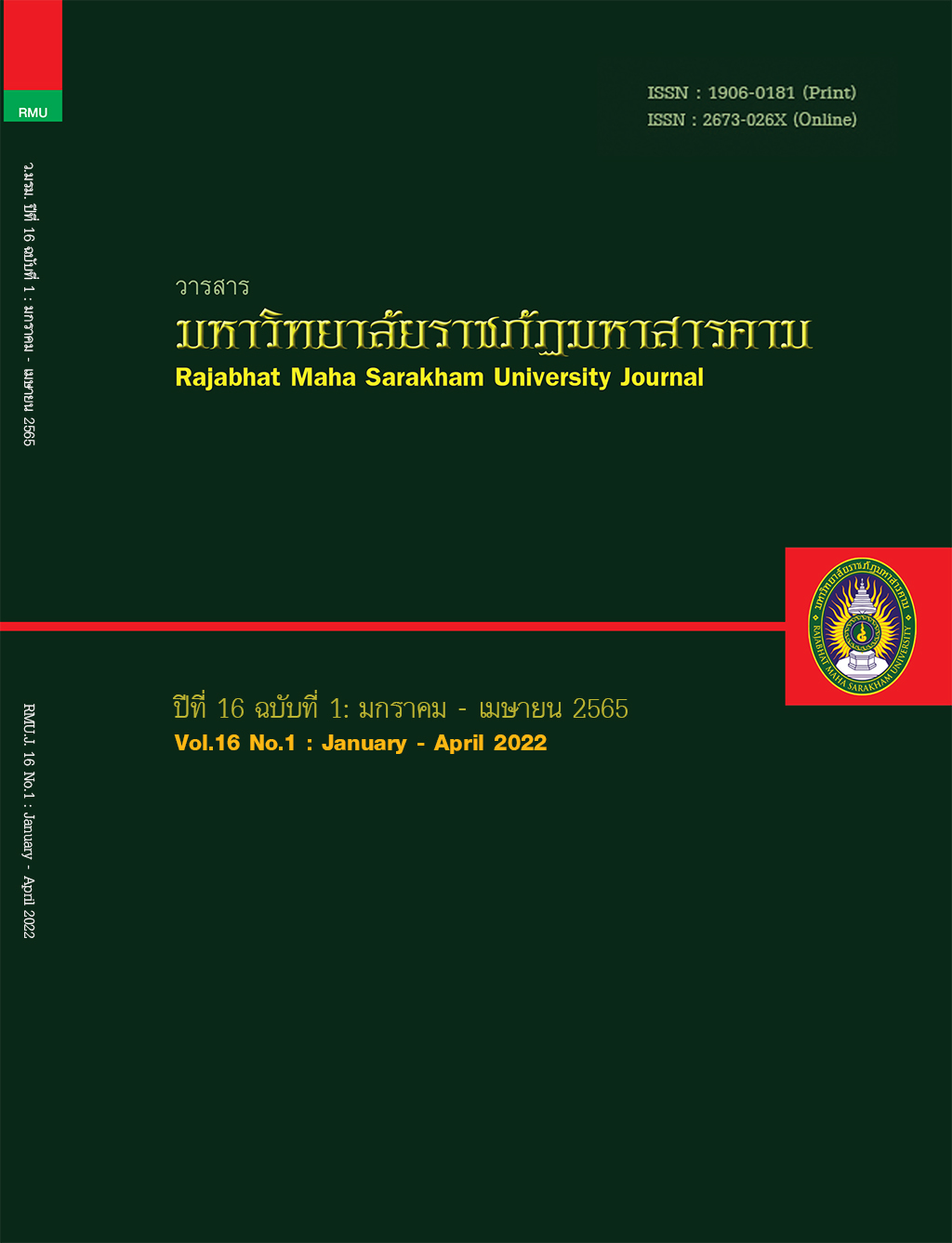การพัฒนากิจกรรมการเรียนรู้คณิตศาสตร์ โดยกลวิธี STAR ร่วมกับการใช้สื่ออิเล็กทรอนิกส์ที่ส่งเสริมความสามารถในการแก้ปัญหาทางคณิตศาสตร์ เรื่อง โจทย์ปัญหาร้อยละ ของนักเรียนชั้นประถมศึกษาปีที่ 5
Main Article Content
บทคัดย่อ
การวิจัยนี้มีวัตถุประสงค์ 1) เพื่อพัฒนากิจกรรมการเรียนรู้คณิตศาสตร์โดยกลวิธี STAR ร่วมกับการใช้สื่ออิเล็กทรอนิกส์ เรื่อง โจทย์ปัญหาร้อยละ ของนักเรียนชั้นประถมศึกษาปีที่ 5 ให้มีประสิทธิภาพตามเกณฑ์ 75/75 2) ศึกษาค่าดัชนีประสิทธิผล 3) เพื่อเปรียบเทียบผลสัมฤทธิ์ทางการเรียนของนักเรียนกับเกณฑ์ร้อยละ 75 4) เพื่อเปรียบเทียบความสามารถในการแก้ปัญหาทางคณิตศาสตร์ของนักเรียน กับเกณฑ์ร้อยละ
75 5) ศึกษาระดับความพึงพอใจที่มีต่อการจัดการเรียนรู้ข้างต้น โดยกลุ่มตัวอย่าง คือ นักเรียนชั้นประถมศึกษาปีที่ 5 จำนวน 13 คน โรงเรียนบ้านพันษี ตำบลจารพัต อำเภอศีขรภูมิ จังหวัดสุรินทร์ ได้มาจากวิธีการสุ่มแบบกลุ่ม เครื่องมือที่ใช้ในการวิจัย ได้แก่ แผนการจัดการเรียนรู้โดยใช้กิจกรรมการจัดการเรียนรู้โดยกลวิธี STAR ร่วมกับการใช้สื่ออิเล็กทรอนิกส์ จำนวน 18 แผน แบบทดสอบวัดผลสัมฤทธิ์ทางการเรียน แบบปรนัยเลือกตอบ จำนวน 20 ข้อ มีค่าดัชนีความสอดคล้อง ตั้งแต่ 0.80-1.00 ค่าความยากตั้งแต่ 0.25-0.80 ค่าอำนาจจำแนกตั้งแต่ 0.21-0.92 ค่าความเชื่อมั่นทั้งฉบับเท่ากับ 0.51 แบบประเมินความสามารถในการแก้ปัญหาทางคณิตศาสตร์ แบบอัตนัย จำนวน 5 ข้อ
มีค่าดัชนีความสอดคล้องเท่ากับ 1.00 ค่าความยากตั้งแต่ 0.30-0.42 ค่าอำนาจจำแนกตั้งแต่ 0.28-0.50 ค่าความเชื่อมั่นทั้งฉบับเท่ากับ 0.87 และแบบสอบถามความพึงพอใจต่อการจัดการเรียนรู้วิชาคณิตศาสตร์ จำนวน 10 ข้อ มีค่าความเที่ยงตรงเชิงเนื้อหาเท่ากับ 1.00 สถิติที่ใช้ในการวิเคราะห์ข้อมูล ได้แก่ ร้อยละ ค่าเฉลี่ย ส่วนเบี่ยงเบนมาตรฐาน และทดสอบสมมติฐานโดยใช้ t-test for One Sample
ผลวิจัยพบว่าแผนการจัดกิจกรรมการเรียนรู้คณิตศาสตร์โดยกลวิธี STAR ร่วมกับการใช้สื่ออิเล็กทรอนิกส์ ประกอบด้วย 4 ขั้นตอน ได้แก่ ศึกษาโจทย์ปัญหา แปลงโจทย์หาคําตอบของโจทย์ปัญหาและทบทวนคําตอบซึ่งประยุกต์การบูรณาการกับการใช้สื่ออิเล็กทรอนิกส์ ในขั้นที่ 2 และ 3 มีประสิทธิภาพ 93.31/85.00 และดัชนีประสิทธิผลเท่ากับ 0.8098 แสดงว่านักเรียนมีความก้าวหน้าเพิ่มขึ้นร้อยละ 80.98 อีกทั้งนักเรียนที่เรียนด้วยกิจกรรมการเรียนรู้ดังกล่าวมีผลสัมฤทธิ์ทางการเรียนและความสามารถในการแก้ปัญหาทางคณิตศาสตร์ คิดเป็นร้อยละ 85.00 และ 84.62 ตามลำดับ สูงกว่าเกณฑ์ร้อยละ 75 ที่ระดับนัยสำคัญ .05 นอกจากนี้ยังมีความพึงพอใจต่อการจัดการเรียนรู้ อยู่ในระดับมากที่สุด ( =4.70 และ S.D.=0.46)
Article Details

อนุญาตภายใต้เงื่อนไข Creative Commons Attribution-NonCommercial-NoDerivatives 4.0 International License.
1. บทความที่ลงตีพิมพ์ทุกเรื่องได้รับการตรวจทางวิชาการโดยผู้ประเมินอิสระ ผู้ทรงคุณวุฒิ (Peer Review) สาขาที่เกี่ยวข้อง อย่างน้อย 3 ท่าน ในรูปแบบ Double blind review
2. ข้อคิดเห็นใด ๆ ของบทความที่ลงตีพิมพ์ในวารสารมหาวิทยาลัยราชภัฏมหาสารคาม นี้เป็นของผู้เขียน คณะผู้จัดทำวารสารไม่จำเป็นต้องเห็นด้วย
3. กองบรรณาธิการวารสารมหาวิทยาลัยราชภัฏมหาสารคาม ไม่สงวนสิทธิ์การคัดลอกแต่ให้อ้างอิงแสดงที่มา
เอกสารอ้างอิง
กรมวิชาการ. (2545). แนวทางการจัดทำหลักสูตรสถานศึกษา.โรงพิมพ์คุรุสภาลาดพร้าว.
กระทรวงศึกษาธิการ. (2560). ตัวชี้วัดและสาระการเรียนรู้แกนกลางกลุ่มสาระการเรียนรู้คณิตศาสตร์ตามหลักสูตรแกนกลางการศึกษาขั้นพื้นฐานพุทธศักราช 2551 (ฉบับปรับปรุง 2560). โรงพิมพ์ชุมนุมสหกรณ์การเกษตรแห่งประเทศไทยจำกัด.
ไชยยัณห์ ชาญปรีชารัตน์. (2543). ความพึงพอใจของนักศึกษาที่มีผลต่อการวัดการเรียนการสอนของโรงเรียนเทคโนโลยีภาคตะวันออกเฉียงเหนือ จังหวัดขอนแก่น. มหาวิทยาลัยมหาสารคาม.
ทองสัตย์, ส. (2558). การศึกษาการสอนแก้ปัญหาคณิตศาสตร์โดยใช้กลวิธี STAR ที่มีต่อความสามารถในการแก้โจทย์ปัญหา และการให้เหตุผลทางคณิตศาสตร์. 989-998.
ศิริทิพย์ ขวัญสมคิด. (2561). ผลสัมฤทธิ์ทางการเรียน คณิตศาสตร์ เรื่องการแก้โจทย์ปัญหาเศษส่วน โดยใช้กลวิธี STAR ของนักเรียนชั้นประถมศึกษาปีที่ 6 โรงเรียนบ้านดอนเคี่ยม.
สมเกียรติ อินทสิงห์. (2559). การพัฒนาความสามารถในการแก้ปัญหาและผลสัมฤทธิ์ทางการเรียนวิชาคณิตศาสตร์โดยใช้กลวิธี STAR ร่วมกับกราฟิกออแกไนซ์เซอร์ สำหรับนักเรียนชั้นมัธยมศึกษาปีที่ 4.วารสารมหาวิทยาลัยศิลปากรสาขามนุษยศาสตร์ สังคมศาสตร์และศิลปะ, 9(1), 356-368.
สุภิดา เที่ยงจันทร์. (2560). ผลการเรียนรู้ผ่านบทเรียนออนไลน์ด้วยกลวิธีการแก้ปัญหา STAR วิชาคณิตศาสตร์ เรื่อง พื้นที่ผิวและปริมาตร ของนักเรียนชั้นมัธยมศึกษาปีที่ 3 โรงเรียนวัดธรรมศาลา (หลวงพ่อน้อยอุปถัมภ์).
สุรชัย ขวัญเมือง. (2532). วิธีสอนและการวัดผลวิชาคณิตศาสตร์ในระดับประถมศึกษา. เทพนิมิตการพิมพ์.
แสงสีบับ, ป. (2005). ผลการจัดการเรียนรู้แบบร่วมมือโดยใช้กลวิธี STAR เรื่อง โจทย์ปัญหาสมการเชิงเส้นตัวแปรเดียว และการแปรผันที่มีต่อความสามารถในการแก้ปัญหา และทักษะการเชื่อมโยงทางคณิตศาสตร์ ของนักเรียนชั้นมัธยมศึกษาปีที่ 2.
Gagnon, J. and Maccini, P. (2011). Mathematics Strategy Instruction (SI) for MiddleSchool Students with Learning Disabilities. http://www.k8accesscenter.org/training_resou rces/massini.asp.
Maccini,P. and Ruhl, K. L. (2000). Effectsof a Graduated Instructional Sequence on the Aigebraic Subtraction of Integers by Secondary Students with Learning Disabilities. Educationand Treatment of Children, 23(4), 465-489.


